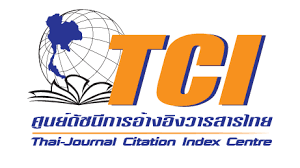การประยุกต์ใช้ข้อมูลที่เปิดเผยสู่สาธารณะของกิจการเพื่อการพยากรณ์ ความล้มเหลวทางการเงิน: กรณีศึกษา ตลาดหลักทรัพย์แห่งประเทศไทย
คำสำคัญ:
การพยากรณ์ความล้มเหลวทางการเงิน, การวิเคราะห์แบบจำแนกประเภท, การวิเคราะห์ความ ถดถอยโลจิสติคบทคัดย่อ
วัตถุประสงค์ของการวิจัยครั้งนี้ 1) เพื่อศึกษาข้อมูลทางการบัญชีและการกำกับดูแลกิจการที่สามารถใช้เป็นปัจจัยในการพยากรณ์ความล้มเหลวทางการเงินใช้สำหรับเป็นเครื่องมือที่ช่วยในการตัดสินใจของนักลงทุนและผู้มีส่วนได้เสีย และ 2) เพื่อสร้างแบบจำลองการพยากรณ์ความล้มเหลวทางการเงินและทำการทดสอบความแม่นยำของแบบจำลอง โดยการเปรียบเทียบการวิเคราะห์จำแนกประเภทกับการวิเคราะห์ความถดถอยโลจิสติคที่เหมาะสมกับบริษัทที่จดทะเบียนในตลาดหลักทรัพย์แห่งประเทศไทย โดยใช้กลุ่มตัวอย่างจำนวน 114 บริษัท แบ่งเป็นบริษัทประสบความล้มเหลวทางการเงินจำนวน 31 บริษัท และบริษัทที่ไม่ประสบความล้มเหลวทางการเงินจำนวน 83 บริษัท โดยคัดเลือกจากกลุ่มอุตสาหกรรม ประเภทหมวดธุรกิจเดียวกัน อยู่ในช่วงระยะเวลาบัญชีเดียวกัน รวมถึงการจับคู่บริษัทที่มีขนาดของสินทรัพย์ใกล้เคียงกัน จากการวิจัยพบว่า ปัจจัยที่มีความสามารถในการนำมาใช้ในการพยากรณ์ความล้มเหลวทางการเงิน ได้แก่ การถือหุ้นของผู้บริหาร สัดส่วนของคณะกรรมการอิสระ สัดส่วนคณะกรรมการตรวจสอบ ผลขาดทุน 2 ปี ติดต่อกัน และอัตราส่วนกระแสเงินสดต่อสินทรัพย์รวม และแบบจำลองที่ใช้วิธีการวิเคราะห์ความถดถอยโลจิสติคมีความสามารถในการจำแนกประเภทบริษัทที่ประสบความล้มเหลวทางการเงินแม่นยำ (ร้อยละ 78.10) สูงกว่าแบบจำลองที่ใช้วิธีการวิเคราะห์จำแนกประเภทมีความสามารถในการจำแนกประเภทบริษัทที่ประสบความล้มเหลวทางการเงินแม่นยำ (ร้อยละ76.30)
References
จินดา ขันทอง. 2541. Red Flags on Financial Failure: The Case of Thai Corporations. วิทยานิพนธ์ระดับปริญญาเอก, จุฬาลงกรณ์มหาวิทยาลัย. กรุงเทพฯ
นันทนัช ธิติสุทธิ. 2556. แบบจำลองการพยากรณ์ความล้มเหลวทางการเงินโดยใช้ Logit Model. การศึกษาค้นคว้าอิสระบัญชีมหาบัณฑิต สาขาบัญชี, มหาวิทยาลัยธรรมศาสตร์. กรุงเทพฯ.
ปานรดา พิลาศรี. 2554. แบบจำลองภาวะความล้มเหลวทางการเงินของบริษัทจดทะเบียนในตลาดหลักทรัพย์แห่งประเทศไทย. การศึกษาค้นคว้าอิสระบัญชีมหาบัณฑิต สาขาบัญชี, มหาวิทยาลัยธรรมศาสตร์. กรุงเทพฯ.
ภรณ์ทิพย์ ชูรอด. 2557. การพยากรณ์ความล้มเหลวทางการเงินของบริษัทจดทะเบียนในตลาดหลักทรัพย์แห่งประเทศไทย. (วิทยานิพนธ์บัญชีมหาบัณฑิต สาขาบัญชี, มหาวิทยาลัยเกษตรศาสตร์).
รวิษฎา สุขแสวง และดารณี เอื้อชนะจิต. 2560. อัตราส่วนทางการเงินที่ทำนายภาวะความล้มเหลวทางธุรกิจของบริษัทที่จดทะเบียนในตลาดหลักทรัพย์แห่งประเทศไทย. (วิทยานิพนธ์ปริญญามหาบัณฑิต, มหาวิทยาลัยธุรกิจบัณฑิตย์).
วิชชกานต์ เมธาวิริยะกุล, ปานฉัตร อาการักษ์ และวัฒนา ยืนยง. (2560). ตัวแบบสัญญาณเตือนภัยล่วงหน้าทางการเงิน: การเปรียบเทียบระหว่างวิธีการถดถอยโลจิสติคและโครงข่ายประสาทเทียมของบริษัทจดทะเบียนในตลาดหลักทรัพย์แห่งประเทศไทย. วารสารวิชาชีพบัญชี, 13(39). 36-57.
Ahamand, H. M. and Adhariani. (2017). Corporate governance determinants for the mitigation of the likelihood of financial distress. Advances in Economics, Business and Management Research, 36, 1-11.
Altman, E. I. (1968). Financial ratio, discriminate analysis and prediction of corporate Bankruptcy. The Journal of Finance, 23(4), 589-609.
Altman, E. I. (1983). Corporate distress, New York: John Wiley.
Bhandari, B. S. (2014). Two discriminant analysis models of predicting business failure: A contrast of the most recent with the first model. American Journal of Management, 14(3). 11-19.
Darrat, A. F., Gray, S., Park, J. C., & Wu, Y. (2016). Corporate governance and bankruptcy risk. Journal of Accounting, Auditing & Finance, 31(2), 163-202.
Deakin, E. B. (1972). A Discriminant analysis of predictors of business failure. Journal of Accounting Research, 10(1), 167-179.
Elisabete S. VI., Carlos P. and Carla C. (2013). Insolvency prediction in the Portuguese construction industry. Marmara Journal of European studies, 21(2), 143-164.
Hair, Joseph F. and others. (2010). Multivariate data analysis: 7th ed. New Jersey: Pearson Prentice Hall.
Hanani, R. T. and Dharmastuti, C. F. (2015). How do corporate governance mechanisms affect a firm’s potential for bankruptcy. Risk Governance & Control: Financial Markets & Institutions, 5(1), 61-70.
Hertz, J., Krogh, A., and Palmer, R., (1991). Introduction to the theory of neural computing computation. New York: Addsion Wesley.
Jonh, A. T., and Ogechukwu, O L. (2018). Corporate governance and financial distress in the banking industry: Nigerian experience. Journal of Economics and Behavioral Studies 10(1), 182-193.
Khunthong, J. (1997). Red flogs on financial failures: The case of Thai corporations. doctoral dissertation in accounting. National Institute of Development Administration, Bangkok.
Ohlson, James A. (1980). Financial ratios and the probabilistic prediction of bankruptcy. Journal of Accounting Research, 18(1), 109-131.
Polsiri, P. and Sookhanaphibarn, K. (2009). Corporate distress prediction models using governance and financial variables: Evidence from Thai listed firms during the East Asian economic crisis. Journal of Economics and Management, 5(2), 273-304.
Pretorius, M. (2009). Defining business decline, failure and turnaround: a content analysis. The Southern African Journal of Entrepreneurship and Small Business Management, 2(1), 116-128.
Salloum, C. and Azoury, N. (2012). Corporate governance and firms in financial distress: evidence from a middle eastern country. International Journal of Business Governance and Ethics, 7(1), 1-17.
Shyam B. B. (2014). Two discriminant analysis models of predicting business failure: A contrast of the most recent with the first model. American Journal of Management, 14(3), 11-19.
Smith, M., Ren, Y. and Dong, Y. (2011). The predictive ability of “Conservatism” and “Governance” variables in corporate financial disclosures. Asian Review of Accounting, 19(2), 171-185.
Viera, S. E., Pinho, C. and Correia, C. (2013). Insolvency prediction in the Portuguese construction industry. Marmara Journal of European Studies, 21(3), 143-165.
Xavier B. (2014). Bankruptcy prediction model using neural networks. Accounting and Finance Research, 2(3), 124-128.
Zmijewski, M. E. (1984). Methodological issues related to the estimation of financial distress prediction models, Journal of Accounting Research, 22(3), 59-82.





